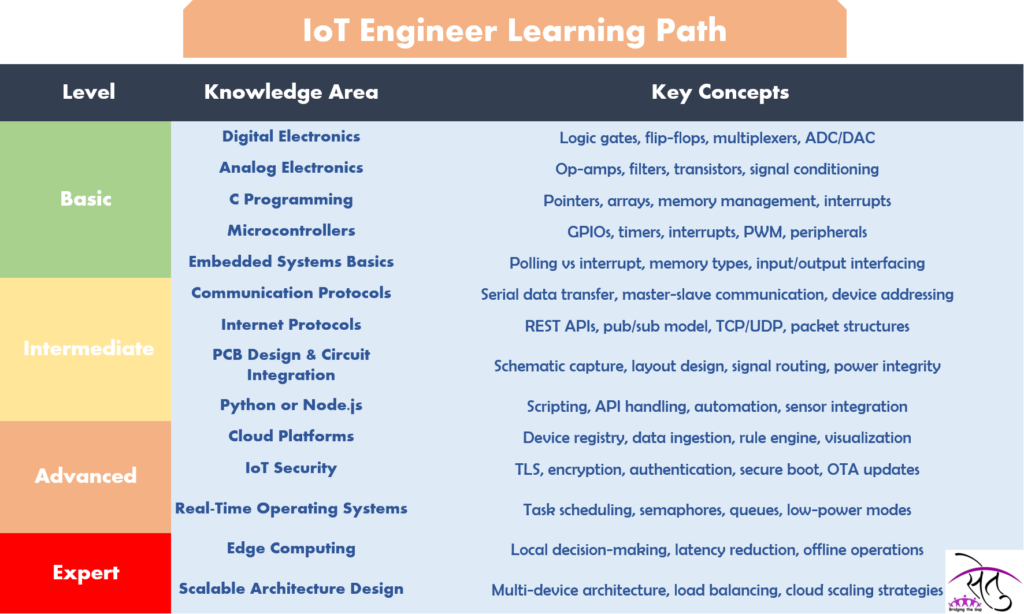An Internet of Things (IoT) Engineer is a technology professional who builds smart systems that connect physical devices to the digital world, enabling data exchange and intelligent automation. These engineers work at the intersection of electronics, embedded systems, wireless communication, cloud computing, and data analytics, playing a vital role in industries ranging from healthcare and agriculture to smart cities and manufacturing. The demand for IoT engineers is rapidly growing due to the global push toward smart infrastructure, sustainable solutions, and real-time analytics. As more devices become interconnected, the role of an IoT engineer continues to evolve—requiring multidisciplinary skills, a strong problem-solving mindset, and an understanding of both software and hardware layers.
As a fresher looking to enter the IoT domain, there are multiple job roles that can serve as strong stepping stones into the industry. You can begin your journey as a Junior IoT Developer, where you’ll work on basic microcontroller programming, sensor integration, and data transmission protocols. Another great entry point is the Embedded Systems Engineer (IoT focus), where you’ll write low-level code for devices and develop firmware for microcontrollers like STM32 or ESP32. If you’re more inclined toward hardware, you could start as a Hardware Prototyping Intern, gaining experience in PCB design and assembling working prototypes. For those interested in quality control, a role as an IoT Test Engineer offers exposure to debugging, testing protocols, and validation of smart devices. You may also consider starting as a Cloud/Edge IoT Support Engineer, helping configure cloud services like AWS IoT or Azure IoT Hub, and understanding how connected systems operate at scale. These roles offer valuable exposure to both hardware and software, allowing you to specialize as you grow in the field.
Begin with core Electronics Fundamentals to understand circuits and components, then move on to Embedded Systems using microcontrollers like Arduino or ESP32. Learn Communication Protocols such as MQTT, Bluetooth, and Wi-Fi, followed by basics of Cloud Platforms (e.g., AWS IoT, Blynk, or ThingsBoard) to handle data and connectivity. Follwoing is the detailed roadmap for the same.

Essential Tools for an IoT Engineer
Tools are essential for IoT engineers as they streamline the process of designing, testing, and deploying connected devices. They help in rapid prototyping, simulate real-world behavior, and reduce development time. The right tools ensure accuracy in communication protocols, sensor integration, and cloud connectivity. Mastering these tools enhances productivity and prepares engineers for industry-level challenges.
| 🔧 Tool Category | 🚀 Popular Tools | 💡 Purpose |
|---|---|---|
| Microcontroller Dev Kits | Arduino, ESP32, Raspberry Pi | Rapid prototyping, device programming, and sensor integration |
| Circuit Design & Simulation | Tinkercad, Proteus, LTSpice | Designing and simulating electronic circuits before physical implementation |
| Programming Platforms | Arduino IDE, PlatformIO, Thonny | Writing and uploading code to IoT hardware |
| Cloud & IoT Platforms | Blynk, Firebase, AWS IoT, ThingsBoard | Remote device monitoring, data visualization, and cloud integration |
| Communication Protocol Tools | Node-RED, MQTT Explorer, Wireshark | Testing and visualizing communication between IoT devices |
Practical Blueprint: Step-by-Step Projects to Master IoT skills
🔹 Basic Level Projects (Beginner)
1. LED Blinker with 555 Timer or Arduino
Learn basic electronics, timing circuits, and microcontroller interfacing.
2. Digital Thermometer using LM35 and Arduino
Understand analog sensors, ADC conversion, and display integration.
3. Soil Moisture Sensor System
Focus on sensor integration and simple analog interfacing.
4. Light-Sensitive Auto ON/OFF System (LDR based)
Practice basic transistor switching and light detection techniques.
🔹 Intermediate Level Projects
1. Temperature & Humidity Logger with DHT11 and ESP32
Work on data acquisition, real-time display, and data logging using Wi-Fi modules.
2. 4×4 Matrix Keypad Controlled Security System
Learn keypad interfacing, password logic, and basic embedded security applications.
3. Mini Power Supply with Voltage Regulation
Build foundational skills in power electronics and voltage regulator circuits.
4. Basic PCB Design for a Power Bank Circuit
Practice PCB layout using tools like KiCad or Altium; understand component placement.
🔹 Advanced Projects
1. IoT-based Smart Energy Meter (with remote data access)
Integrate MCU programming with real-time energy monitoring and cloud communication.
2. Touchscreen-based Home Automation System
Combine user interfaces with embedded systems for controlling household appliances.
3. Microcontroller-based Battery Management System (BMS)
Learn current sensing, battery protection logic, and embedded design for energy systems.
4. Embedded Audio Amplifier with Equalizer
Apply signal processing, analog design, and filter implementation.
🔹 Industrial-Level Projects
1. Custom PCB Design for Wearable Health Monitoring Device
Design compact, power-efficient multilayer PCBs with embedded firmware.
2. FPGA-based Signal Processing System
Use VHDL/Verilog for high-speed data processing and digital logic design.
3. Industrial Automation Control Board (Modbus/RS-485 Interface)
Develop robust communication boards for PLC-based automation using standard protocols.
4. Smart Sensor Node for Industrial IoT (IIoT)
Build rugged, scalable sensor modules with wireless transmission and data fusion.
Top Companies Hiring IoT Engineers
Bosch
- Website: https://www.bosch.com
Intel
- Website: https://www.intel.com
Qualcomm
- Website: https://www.qualcomm.com
Honeywell
- Website: https://www.honeywell.com
Tata Elxsi
- Website: https://www.tataelxsi.com
Cisco Systems
Website: https://www.cisco.com
